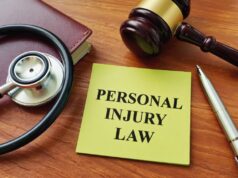When accidents happen, the legal principle of negligence often comes into play in determining who is liable for the injuries and damages that result. In personal injury lawsuits, proving negligence is crucial for securing compensation for the injured party. Whether it’s a car accident, slip and fall, or a medical malpractice claim, understanding how negligence works is fundamental to building a strong case.
If you or a loved one has been injured due to someone else’s negligence, contacting a personal injury attorney in Fort Wayne can help you navigate the legal complexities and fight for the compensation you deserve. An experienced attorney can guide you through the process, ensuring that all elements of negligence are properly established in your case.
Photo by RDNE Stock project: https://www.pexels.com/photo/man-in-black-suit-holding-white-ceramic-mug-6069474/
What is Negligence?
Negligence occurs when a person or entity fails to exercise the level of care that a reasonable person would have in the same situation, leading to harm or injury to another party. In legal terms, negligence is often defined by four essential elements: duty of care, breach of duty, causation, and damages. Understanding these elements is key to determining whether a party can be held liable for personal injury.
In personal injury lawsuits, the injured party (plaintiff) must prove that the other party (defendant) was negligent and that this negligence directly caused their injuries. Let’s explore each of the elements of negligence in more detail.
1. Duty of Care
The first element in establishing negligence is proving that the defendant owed the plaintiff a duty of care. A duty of care is a legal obligation to act in a way that avoids causing harm to others. This duty varies depending on the circumstances of the case and the relationship between the parties involved.
For example, drivers have a duty to operate their vehicles safely and obey traffic laws to prevent accidents. Similarly, property owners have a duty to maintain their premises in a reasonably safe condition to prevent visitors from getting injured. In a medical setting, doctors and healthcare providers have a duty to provide care that meets the accepted standard of care in their profession.
2. Breach of Duty
Once a duty of care has been established, the next step is to prove that the defendant breached this duty. A breach occurs when the defendant fails to act with the level of care that a reasonably prudent person would have in the same situation. This can involve either doing something reckless or failing to take appropriate action.
For example, in a car accident case, a breach of duty might occur if the driver was speeding, texting while driving, or driving under the influence of alcohol. In a slip and fall case, a breach of duty could involve a property owner failing to repair a known hazard, such as a broken step or wet floor, that ultimately leads to an injury.
The breach of duty is often where the legal battle intensifies, as the plaintiff must show that the defendant’s actions (or lack thereof) fell below the expected standard of care.
3. Causation
Causation is the third element in a negligence claim and requires the plaintiff to prove that the defendant’s breach of duty directly caused their injuries. This is often referred to as “proximate cause” in legal terms, meaning that the injury must be a foreseeable result of the defendant’s actions or inaction.
In some cases, proving causation can be straightforward. For instance, if a driver runs a red light and crashes into another vehicle, causing injuries, the connection between the breach of duty (running the red light) and the resulting injuries is clear. However, in more complex cases—such as medical malpractice or product liability claims—establishing causation may require expert testimony or additional evidence.
It’s also important to note that some states, including Indiana, follow a comparative fault rule, which allows for the possibility that both the plaintiff and defendant share responsibility for the accident. In these cases, the court may assign a percentage of fault to each party, which can affect the amount of compensation the plaintiff is entitled to receive.
4. Damages
The final element in proving negligence is demonstrating that the plaintiff suffered actual damages as a result of the defendant’s actions. Damages can include physical injuries, emotional distress, medical expenses, lost wages, and property damage. Without demonstrating that damages occurred, there is no basis for a personal injury lawsuit.
For example, if a pedestrian is hit by a car and suffers broken bones, medical bills, and lost income from time off work, these would be considered damages that could be recovered through a personal injury claim. In addition to tangible damages, plaintiffs can also seek compensation for pain and suffering, emotional trauma, and loss of enjoyment of life.
The Role of Negligence in Different Types of Personal Injury Cases
Negligence is the cornerstone of most personal injury lawsuits, regardless of the type of accident or injury involved. Here’s a look at how negligence plays a role in some of the most common personal injury cases:
1. Car Accidents
Car accidents are one of the most common causes of personal injury claims, and proving negligence is crucial in these cases. Drivers who engage in reckless or careless behavior—such as speeding, running red lights, or driving under the influence—can be held liable for injuries resulting from a crash. In addition to the driver, other parties such as vehicle manufacturers or government entities responsible for road maintenance may also be held liable if their negligence contributed to the accident.
2. Slip and Fall Accidents
Slip and fall accidents often occur due to hazardous conditions on someone else’s property, such as wet floors, uneven surfaces, or poorly maintained walkways. In these cases, the property owner may be held liable for failing to address the dangerous condition or for not warning visitors about the potential risk. Proving negligence in slip and fall cases typically requires showing that the property owner knew (or should have known) about the hazard and failed to take appropriate action.
3. Medical Malpractice
Medical malpractice occurs when a healthcare provider’s negligence results in harm to a patient. This can include errors in diagnosis, treatment, surgery, or medication administration. Proving negligence in medical malpractice cases can be complex, as it often requires expert testimony to demonstrate that the healthcare provider’s actions deviated from the accepted standard of care in the medical field.
4. Product Liability
In product liability cases, negligence occurs when a manufacturer, distributor, or retailer fails to ensure that a product is safe for use, leading to injury or death. This can include defects in the design, manufacturing, or labeling of a product. In some cases, multiple parties may be held liable for the injuries caused by a defective product.
How a Personal Injury Attorney Can Help
Proving negligence can be a complicated and time-consuming process, especially when dealing with insurance companies or large corporations. An experienced personal injury attorney in Fort Wayne can help you navigate the legal system, gather the necessary evidence, and build a strong case to prove negligence on the part of the responsible party.
Personal injury attorneys play a critical role in handling all aspects of your claim, from investigating the accident and interviewing witnesses to negotiating with insurance companies and representing you in court. Having legal representation can significantly increase your chances of securing a fair settlement or verdict, allowing you to recover the compensation you deserve for your injuries.
Conclusion
Negligence is the key element in most personal injury lawsuits, and proving it requires a thorough understanding of the law and careful presentation of evidence. Whether you’ve been injured in a car accident, slip and fall, or medical malpractice case, demonstrating that another party’s negligence led to your injuries is essential for obtaining compensation.
If you or a loved one has suffered injuries due to someone else’s negligence, it’s important to consult with a personal injury attorney in Fort Wayne to understand your legal rights and options. An experienced attorney can help you gather evidence, prove negligence, and pursue a claim that will help you recover the damages you need to move forward.




